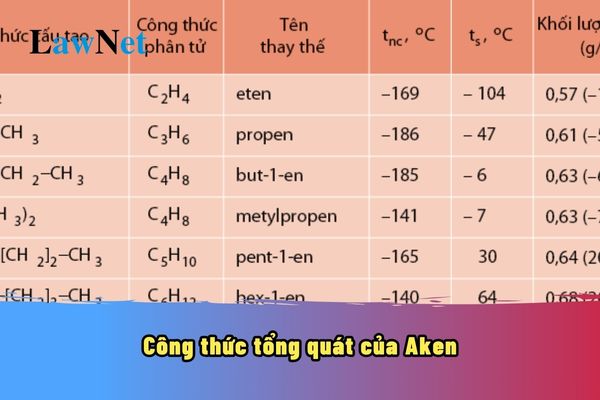What is the general formula for Alkenes? What are the features of the 11th-grade Chemistry curriculum in Vietnam?
What is the general formula for Alkenes?
Alkenes are unsaturated hydrocarbons with an open chain and contain a double bond C=C within the molecule. They form a homologous series with the general formula:
CnH2n (with n ≥ 2)
*Where:
n: is the number of carbon atoms in the molecule.
*Significance of the general formula:
Elemental Composition: Indicates that the alkene molecule contains only two elements, carbon and hydrogen.
Calculations: Based on the general formula, we can calculate the molar mass, the percentage of elemental mass, etc., of any alkene when the number of carbons is known.
Example:
Ethylene (C₂H₄)
Propene (C₃H₆)
Butene (C₄H₈)
Double Bond: Each C=C double bond reduces the molecule by 2 hydrogen atoms compared to the corresponding alkane.
Open Chain: Ensures this general formula applies to all alkenes.
*Note:
Isomerism: Alkenes from C₄H₈ onwards exhibit isomerism regarding the position of the double bond and the carbon chain.
Chemical Properties: The C=C double bond is the characteristic reaction center of alkenes. They participate in many addition and polymerization reactions.
*Note: Information is only for reference purposes./.

What is the general formula for Alkenes? What are the features of the 11th-grade Chemistry curriculum in Vietnam? (Image from the Internet)
What are the features of the 11th-grade Chemistry curriculum in Vietnam?
According to sub-section 1, Section V of the General education program in Chemistry issued along with Circular 32/2018/TT-BGDDT, the 11th-grade Chemistry curriculum shares the common features of the entire high school Chemistry curriculum as follows:
- Chemistry is a science discipline belonging to the natural sciences field, studying the composition, structure, properties, and transformation of elements and compounds.
- Chemistry tightly combines theory and experiment, serving as a bridge between other natural sciences like physics, biology, medicine, and geology. The advancements in chemistry are closely linked with new discoveries in biology, medicine, and physics.
- Chemistry plays an essential role in life, production, contributing to socio-economic development. Chemical achievements are applied in fields like materials, energy, medicine, biotechnology, agriculture, forestry, and fisheries, among others.
- In the general education curriculum, Chemistry is a natural science subject at the high school level, chosen by students based on their career orientation, interests, and abilities. It helps students acquire core chemistry knowledge and apply these understandings in life, while also relating to various educational fields.
- Together with Mathematics, Physics, Biology, Informatics, and Technology, Chemistry promotes STEM education, a significant educational trend in many countries worldwide.
- Chemistry content is organized into topics to ensure the consolidation of linear content, developing knowledge and practical skills formed in earlier education levels, and helping students gain deeper insights into fundamental chemical knowledge for learning, working, and researching purposes.
- Each academic year, students with career orientation need to utilize extensive chemistry knowledge, selecting three academic topics that suit personal aspirations and school organization conditions.
These academic topics fulfill the requirement of deep differentiation, helping students enhance knowledge and practical skills, apply learned knowledge and skills to address real-world issues, meeting career orientation requirements.
What are the perspectives on developing the 11th-grade Chemistry curriculum in Vietnam?
Under Section II of the General education program in Chemistry issued with Circular 32/2018/TT-BGDDT, the perspectives on developing the 11th-grade Chemistry curriculum in Vietnam are specified as follows:
The Chemistry curriculum fully complies with the regulations stated in the Overall Program while emphasizing the following perspectives based on subject characteristics:
[1] Ensuring Continuity and Development
- The Chemistry curriculum inherits and promotes the advantages of the current program, assimilates the experience of building subject programs from countries with advanced educational systems globally and in the region; while also approaches achievements in educational science and chemistry that suit the cognitive abilities and psychological characteristics of students, considering Vietnam's economic and social conditions.
- The Chemistry curriculum builds on and expands the educational content of Natural Science at the lower secondary level, combining concentric and linear structural approaches to broaden and elevate students' knowledge and skills.
At the lower secondary level, through Natural Science, students are introduced to basic chemical knowledge at a qualitative, visually descriptive level. At the high school level, Chemistry focuses on equipping students with fundamental chemical knowledge on the structure, properties, and applications of elements and compounds so they can explain the essence of chemical change processes at the necessary level.
[2] Ensuring Practicality
The Chemistry curriculum emphasizes practicality; avoids a tendency towards calculations; focuses on equipping conceptual tools and methods of tool usage, especially helping students gain practical experimental skills and the ability to apply chemical knowledge to understand and solve certain practical issues, meeting life’s requirements.
[3] Implementing Career Orientation
The Chemistry curriculum articulates career-oriented education goals. Based on identifying specialized fields and technology processes requiring in-depth chemical knowledge, the program selects core educational content and academic topics, aiding students in gaining deeper insights into chemical knowledge with numerous practical applications, preparing them for career orientation.
[4] Promoting Student Activeness
The educational methods of the Chemistry curriculum aim to promote student activeness, initiative, and creativity, to form chemistry competencies and contribute to forming and developing essential qualities and common competencies as defined in the Overall Program.

